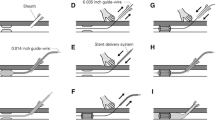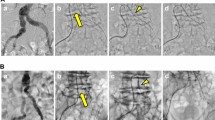Abstract
To describe an innovative distal protection technique, “sheath rendezvous method”, during endovascular treatment for subclavian arterial occlusions. 4.5F and 6F guiding sheath were inserted from left brachial and common femoral artery, respectively. 0.014″ guidewire retrogradely passed through occlusion and into antegrade sheath to establish a pull-through system. 3.0 mm balloon was used to expand occlusion and anchor to deliver retrograde sheath into antegrade one. Both sheaths locked by balloon dilatation crossed occlusion until antegrade sheath passed over lesion. Balloon expandable stent was delivered within antegrade sheath. Sheath was removed, and stent was implanted. We obtained an excellent outcome without complications.




Similar content being viewed by others
References
Edwards WH, Mulherin JL Jr. The surgical reconstruction of the proximal subclavian and vertebral artery. J Vasc Surg. 1985;2:634–42.
Wylie EJ, Effeney DJ. Surgery of the aortic arch branches and vertebral arteries. Surg Clin North Am. 1979;59:669–80.
AbuRahma AF, Bates MC, Stone PA, et al. Angioplasty and stenting versus carotid-subclavian bypass for the treatment of isolated subclavian artery disease. J Endovasc Ther. 2007;14:698–704.
McNamara TO, Greaser LE 3rd, Fischer JR, et al. Initial and long-term results of treatment of brachiocephalic arterial stenoses and occlusions with balloon angioplasty, thrombolysis, stents. J Invasive Cardiol. 1997;9:372–83.
Higashimori A, Morioka N, Shiotani S, et al. Long-term results of primary stenting for subclavian artery disease. Catheter Cardiovasc Interv. 2013;82:696–700.
Sixt S, Rastan A, Schwarzwälder U, et al. Results after balloon angioplasty or stenting of atherosclerotic subclavian artery obstruction. Catheter Cardiovasc Interv. 2009;73:395–403.
Ackermann H, Diener HC, Seboldt H, et al. Ultrasonographic follow-up of subclavian stenosis and occlusion: natural history and surgical treatment. Stroke. 1988;19:431–5.
Tyras DH, Barner HB. Coronary-subclavian steal. Arch Surg. 1977;112:1125–7.
Hadjipetrou P, Cox S, Piemonte T, et al. Percutanous revascularization of atherosclerotic obstruction of aortic arch vessels. J Am Coll Cardiol. 1999;33:1238–45.
Bachman DM, Kim RM. Transluminal dilatation for subclavian steal syndrome. Am J Roentgenol. 1980;135:995–6.
Bogey WM, Demasi RJ, Tripp MD, et al. Percutaneous transluminal angioplasty for subclavian artery stenosis. Am Surg. 1994;60:103–6.
Sullivan TM, Gray BH, Bacharach JM, et al. Angioplasty and primary stenting of subclavian, innominate, and common carotid arteries in 83 patients. J Vasc Surg. 1998;28:1059–65.
Gahremanpour A, Perin EC, Silva G. Carotid artery stenting versus endarterectomy: a systematic review. Tex Heart Inst J. 2012;39:474–87.
Cremonesi A, Manetti R, Setacci F, et al. Protected carotid stenting: clinical advantages and complications of embolic protection devices in 442 consecutive patients. Stroke. 2003;34:1936–41.
Ringelstein EB, Zeumer H. Delayed reversal of vertebral artery blood flow following percutaneous transluminal angioplasty for subclavian steal syndrome. Neuroradiology. 1984;26:189–98.
Acknowledgments
None.
Author information
Authors and Affiliations
Corresponding author
Ethics declarations
Conflict of interest
All authors have no commercial, proprietary, or financial interest in any products or companies described in this article.
Rights and permissions
About this article
Cite this article
Haraguchi, T., Urasawa, K., Nakama, T. et al. Sheath rendezvous method: a novel distal protection technique during endovascular treatment of subclavian artery occlusions. Cardiovasc Interv and Ther 31, 279–283 (2016). https://doi.org/10.1007/s12928-015-0348-y
Received:
Accepted:
Published:
Issue Date:
DOI: https://doi.org/10.1007/s12928-015-0348-y




